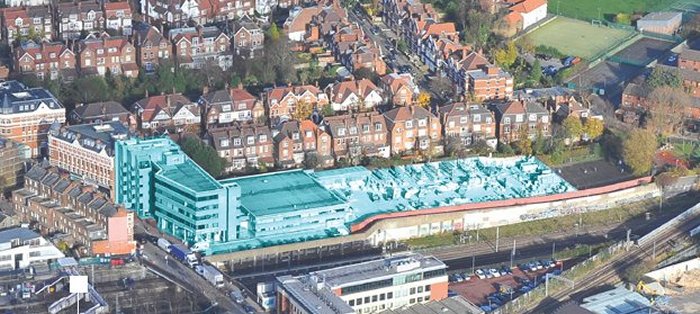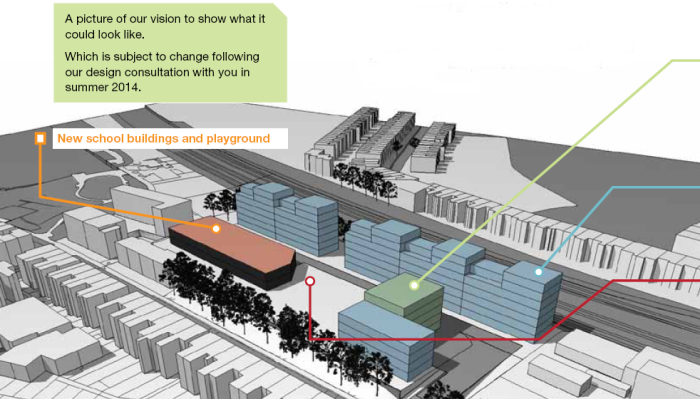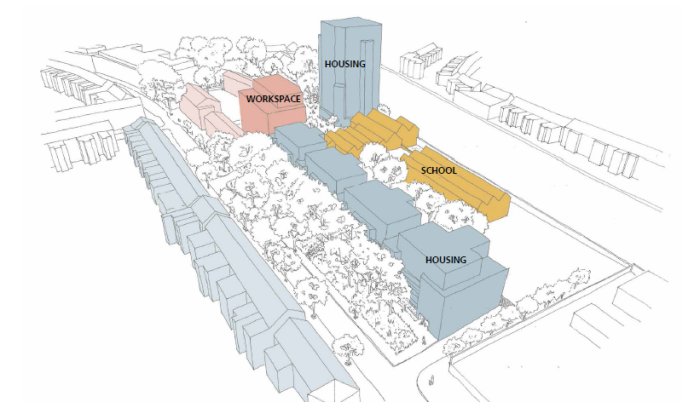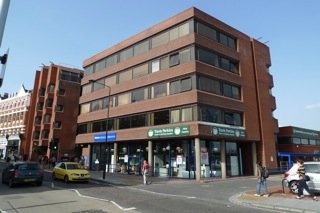Affordable housing for 156 West End Lane

The surprisingly large 156 West End Lane site
The proposed redevelopment of Liddell Road includes 105 flats of which precisely none are currently designated for affordable housing. Camden’s policy is that 50% of floorspace in any development of more than 50 units should be affordable (although understanding what affordable means in practice is not easy, as we’ll see later).
Why then does a development Camden is pushing itself have no affordable housing when its own quota is 50%? The council argues that it’s to pay for the school that will also be built on the same site. This starts to make more sense, although critics have pointed out that Camden is set to make a £3m surplus from the redevelopment and is redirecting central government funding of £6m – specifically earmarked for schools – to other parts of the borough.
Camden’s other argument is that the redevelopment of another large site it owns – 156 West End Lane, aka the Travis Perkins building – will reach the affordable housing quota. You can see the Twitter conversation where Cllr Phil Jones confirms this.

It doesn’t take a genius to work out that one development meeting quota doesn’t offset another that doesn’t; however, if you are prepared to accept the argument that the market rate housing pays for the school then it’s a lot better than nothing.
The challenge is that the 156 West End Lane plans are still some way off and plans can change – as we’ve seen with Liddell Road.

Liddell Road proposal from last year (acknowledging it might change)

Revised Liddell Road plan with 14-storey tower block
The Travis Perkins site has been sold to a private developer (sources tell me for “top dollar”), it will be interesting to see how Camden plans to enforce that 50% quota. Failing to do so would continue to propel West Hampstead down a track of becoming an increasingly homogenous affluent youngish community.
Many might think that sounds quite nice. Others might think that the best communities are those that are more mixed, offering suitable employment and accommodation to a wide range of people. There is a risk that the existing council estates in the area become more marginalised, that any sense of social cohesion is eroded and that the services and shops in the area cater increasingly for one – well heeled – section of the community only. Bear in mind that a key tenet of Camden’s core strategy is that it aims “to minimise social polarisation and create mixed and inclusive communities across Camden”.

Still empty above the ground floor
Underpinning much of this is the question, “what does affordable mean?”. It’s a simple question that turns out to be almost impossible to answer in a way that means much to most people.
Lets look first at the definition, then at the types of housing included and then at what the catch-all term “affordable housing” means in terms of actual units built on the ground.
What’s “affordable”?
Affordable housing should:
- meet the needs of households whose needs are not met by the market and who are eligible for affordable housing, and
- be provided at a cost they can afford, taking into account local household incomes and market housing costs, and
- be affordable to future households unless arrangements are in place for subsidies to be recycled into alternative affordable housing provision.
Three types of affordable housing
Social rented housing is primarily housing managed by local councils and housing associations. The cost of social rented housing is controlled by a national rent regime. Other affordable housing providers may manage social rented housing under the same rental arrangements. This is what most people think of as “council housing”.
Intermediate affordable housing costs more than social housing but less than equivalent market housing. Camden controls the cost of intermediate affordable housing taking into account market costs and the eligible income groups. The Mayor’s February 2011 review indicated that eligible households were those with incomes of less than £64,000 per year (gross). The draft replacement London Plan indicates that he intends to raise the eligible income to £74,000 per year for intermediate affordable homes with 2-bedrooms or more.
How does income covert into housing costs? At the moment, in London, intermediate affordable housing should cost no more than 3.5x the household income threshold to buy and no more than 40% of net household income including rent and service charges.
Most intermediate affordable housing in Camden has been provided by housing associations. Intermediate affordable housing can include a range of tenures such as: rented housing, shared-ownership housing (where occupiers buy a share and rent the remainder) and low cost homes for sale.
Affordable rented housing means rents up to 80% of market levels, although the individual housing associations that manage this sort of affordable housing set their levels. Clearly, 80% of market levels is still far too high for many people. The Valuation Office’s October 2013 data put the average monthly rent of a 3-bed house in Camden at £2,976, 80% of which would be £2,380 – well beyond the reach of many.
Affordable rent was introduced as the grant available for affordable housing development for 2011-15 was halved from its previous level. It allows social housing providers charge up to 80% of market levels, and use the increased rental income to support additional borrowing to compensate for reduced grant.
Housing associations operating in areas with high land and market rental values such as West Hampstead will often have to manage affordable housing developed as part of private developments rather than developing their own – as is happening at West Hampstead Square, for example.
The associations have to cover their costs, so in expensive areas, they may be forced to charge the maximum 80% level, even though that is still a high absolute amount.
What does it mean on the ground?
Camden has changed its affordable housing quota recently. It used to be 50% of floorspace in any development of more than 10 units had to be “affordable housing”. It’s now moved to a sliding scale so 50% of any development of more than 50 units must be affordable, 40% of developments of more than 40 units, and so on.
In terms of the split between the various types of affordable housing, this has changed to 60% social rented and 40% intermediate housing, down from 70/30. This is, says Camden, because it believes that just over half of Camden residents in need of affordable housing could afford intermediate housing.
Further reading
No-one would pretend this was a simple topic to understand, and with national, city and borough policies to take into account, it’s impossible to say “affordable housing = x thousand pounds”.
If you want to delve into more detail, then I suggest
Camden Housing Strategy 2011-16 , which is the most accessible document and sets out more of the context.
Camden’s Planning Guidance goes into more detail
The 2011 London Plan on housing explains the Mayor’s position
Camden Core Strategy CS6 (Housing) is the official policy document




The lack of “affordable housing” is bad enough but even “affordable housing” isn’t actually affordable for many people. What I want to know is what about council housing? Why is Camden Council selling off OUR land when there is an urgent need for council housing in the borough? Apart from this site and the Liddell Road site I can’t think of any other locations in the West Hampstead area where Camden could build new council housing. All this land will be developed without a single council flat being built – it’s absolutely disgusting! I really feel for people who aren’t fortune enough to own their own property and can’t even get a place to call home from the council. Shame on Camden’s Councillors who orchestrated this selling off of public land when there is no other land that can be used to build council homes nearby.
Bollocks to council housing. If can’t afford to life in West Hampstead, move to Cricklewood.
And what about when you can’t afford to live in Cricklewood?